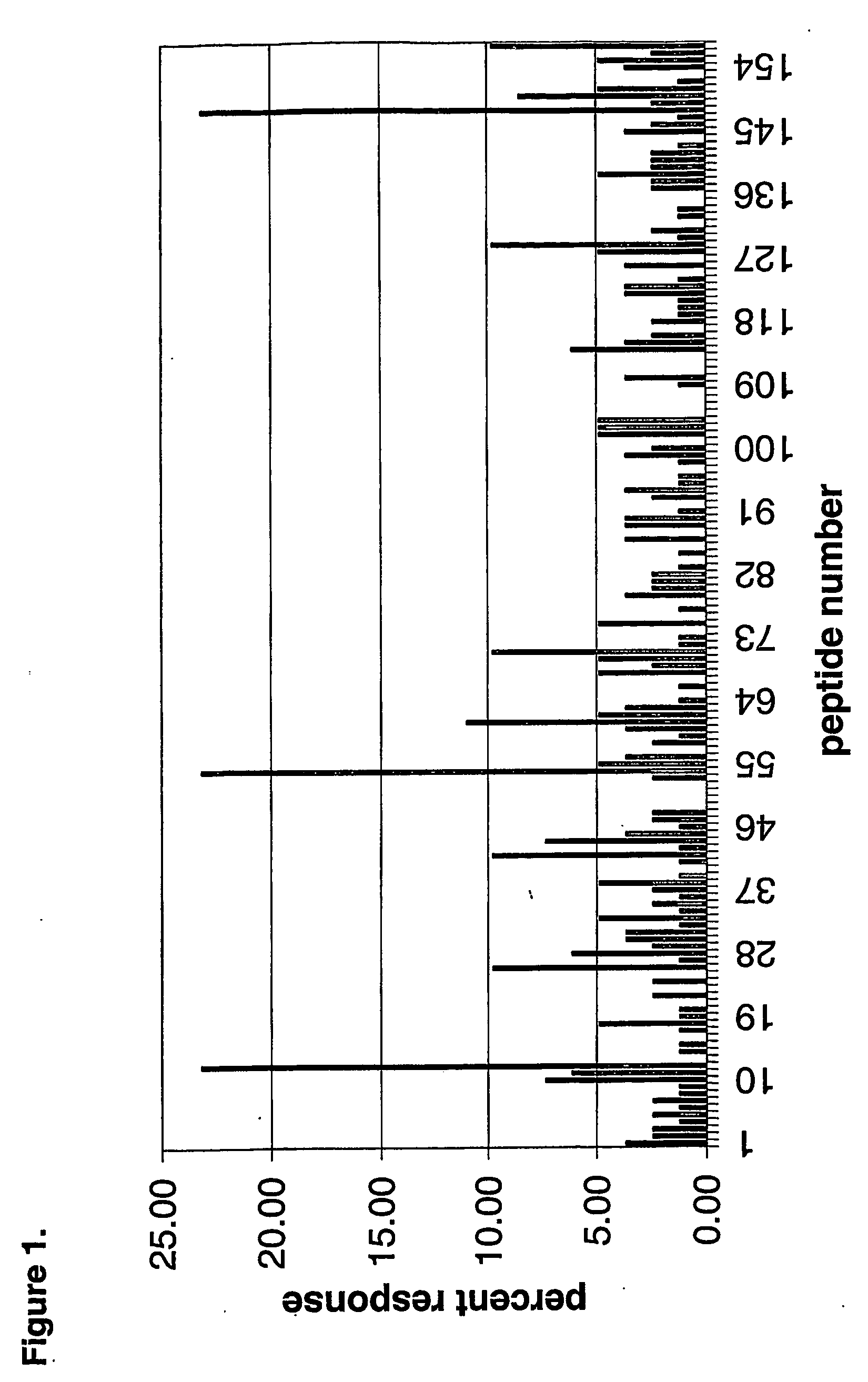Amylases producing an altered immunogenic response and methods of making and using the same
- Summary
- Abstract
- Description
- Claims
- Application Information
AI Technical Summary
Benefits of technology
Problems solved by technology
Method used
Image
Examples
example 1
Preparation of Cells Used in the I-MUNE® Assay System for the Identification of Peptide T-Cell Epitopes in Alpha Amylase Using Human T-Cells
[0173] Fresh human peripheral blood cells were collected from 82 humans of unknown exposure status to IFN-β. These cells were tested to determine antigenic epitopes in IFN-β, as described in Example 3.
[0174] Peripheral mononuclear blood cells (stored at room temperature, no older than 24 hours) were prepared for use as follows: Approximately 30 mls of a solution of buffy coat preparation from one unit of whole blood was brought to 50 ml with Dulbecco's phosphate buffered solution (DPBS) and split into two tubes. The samples were underlaid with 12.5 ml of room temperature Lymphoprep density separation media (Nycomed; Pharma AS; Density 1.077 giml). The tubes were centrifuged for thirty minutes at 600 xg. The interface of the two phases was collected, pooled and washed in DPBS. The cell density of the resultant solution was measured by hemocytom...
example 2
Identification of T-Cell Epitopes in Alpha Amylase
[0181] Peptides for use in the I-MUNE® assay described in Example 3 were prepared based on the sequence of B. licheniformis alpha amylase (Genbank P6278) with the sequence: [0182] mkqqkrlyar lltlifalif llphsaaaaa nlngtlmqyf ewympndgqh wkrlqndsay laehgitavw ippaykgtsq advgygaydl ydlgefhqkg tvrtkygtkg elqsaikslh srdinvygdv vinhkggada tedvtavevd padmrvisg ehrikawthf hfpgrgstys dfkwhwyhfd gtdwdesrkl nriykfqgka wdwevsneng nydylmyadi dydhpdvaae ikrwgtwyan elqldgfrld avkhikfsfl rdwvnhvrek tgkemftvae ywqndlgale nylnktnfnh svfdvplhyq fhaastqggg ydmrkllnst vvskhplkav tfvdnhdtqp gqslestvqt wfkplayafi ltresgypqv fygdmygtkg dsqreipalk hkiepilkar kqyaygaqhd yfdhhdivgw tregdssvan sglaalitdg pggakrmyvg rqnagetwhd itgnrsepw insegwgefh vnggsvsiyv qr (SEQ ID NO:1).
[0183] Based upon the full length amino acid sequence (SEQ ID NO:1) of this α-amylase, a set of 157 15mers off-set by three amino acids comprising the entire sequence of α-amylase were synt...
example 3
I-MUNE® Assay for the Identification of Peptide T-Cell Epitopes in Alpha Amylase Usinq Human T-Cells
[0189] Once the assay reagents (i.e., cells, peptides, etc.) were prepared and distributed into the 96-well plates, the I-MUNE® assays were conducted. Controls included dendritic cells plus CD4+ T-cells alone (with DMSO carrier) and with tetanus toxoid (Wyeth-Ayerst), at approximately 5 Lf / mL.
[0190] Cultures were incubated at 37° C. in 5% CO2 for 5 days. Tritiated thymidine (NEN) was added at 0.5 microCi / well. The cultures were harvested and assessed for incorporation the next day, using the Wallac TriBeta scintillation detection system (Wallace Oy).
[0191] All tests were performed at least in duplicate. All tests reported displayed robust positive control responses to the antigen tetanus toxoid. Responses were averaged within each experiment, then normalized to the baseline response. A positive event (i.e., a proliferative response) was recorded if the response was at least 2.95 ti...
PUM
| Property | Measurement | Unit |
|---|---|---|
| Fraction | aaaaa | aaaaa |
| Fraction | aaaaa | aaaaa |
| Fraction | aaaaa | aaaaa |
Abstract
Description
Claims
Application Information
 Login to View More
Login to View More - R&D
- Intellectual Property
- Life Sciences
- Materials
- Tech Scout
- Unparalleled Data Quality
- Higher Quality Content
- 60% Fewer Hallucinations
Browse by: Latest US Patents, China's latest patents, Technical Efficacy Thesaurus, Application Domain, Technology Topic, Popular Technical Reports.
© 2025 PatSnap. All rights reserved.Legal|Privacy policy|Modern Slavery Act Transparency Statement|Sitemap|About US| Contact US: help@patsnap.com

